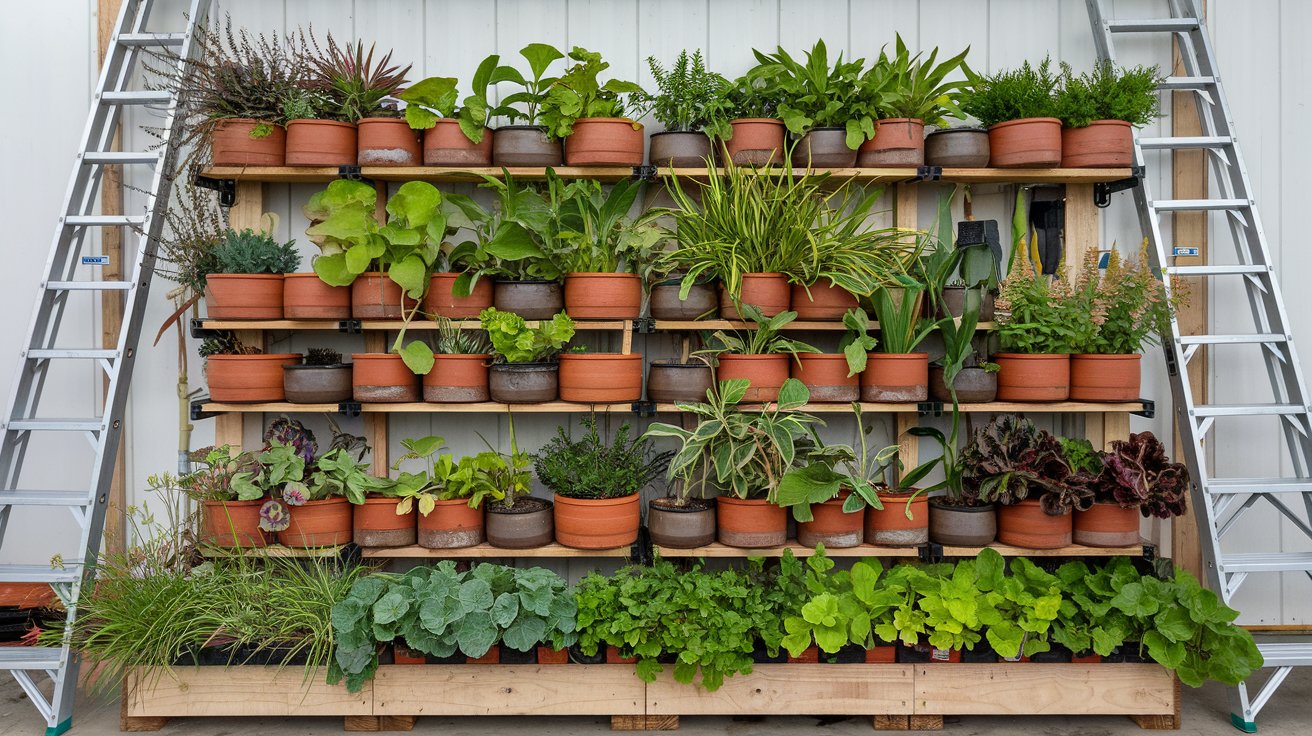Urban living and small spaces often leave little room for a traditional vegetable garden, but don’t let that deter you from growing your own food. With the right strategies, even the most compact spaces—like apartments, balconies, and small yards—can accommodate a thriving vegetable garden. By using creative vegetable garden ideas, you can cultivate fresh produce in even the tightest areas. This article will introduce 10 inventive ways to maximize space and grow your own vegetables in small spaces.
Whether you’re an experienced gardener or just getting started, there are plenty of options for small space gardening. From container gardens to vertical planting systems, you’ll learn how to grow vegetables efficiently while making the most of your limited space.
Key Takeaways:
- Discover 10 creative vegetable garden ideas perfect for small spaces
- Learn how to maximize your garden’s potential with smart space-saving techniques
- Explore unique gardening methods like container gardening, vertical systems, and hydroponics
- Uncover tips for growing your own vegetables and herbs, even in tight areas
- Gain insights on the best tools and materials for small space gardening
Table of Contents
Container Gardening: Grow Vegetables Anywhere
Container gardening is an accessible and highly versatile gardening method that works well in small spaces. The beauty of container gardening is its ability to fit almost anywhere—on a balcony, windowsill, or even in a corner of your kitchen. By using pots, baskets, or even repurposed containers, you can create a thriving vegetable garden without taking up much space.
The key to success with container gardening is selecting the right containers for your plants. Larger containers are often better suited for root vegetables like carrots or potatoes, while smaller containers are perfect for herbs, lettuce, or tomatoes. Ensure the containers have proper drainage to prevent waterlogging, which could lead to root rot.
Best Vegetables for Container Gardening
- Tomatoes: Choose compact varieties like ‘Tiny Tim’ or ‘Patio Princess’
- Lettuce: Ideal for shallow containers, and it grows quickly
- Radishes: Perfect for small pots due to their quick growth cycle
- Peppers: Compact varieties like bell peppers or chili peppers thrive in containers
Using a variety of container sizes allows you to grow multiple types of vegetables in a limited space. For example, you can place a few medium-sized pots for tomatoes and peppers while filling smaller containers with herbs like basil, parsley, and thyme. The mobility of containers also allows you to move your plants around to catch the sun, or bring them inside during cold weather.

Vertical Gardening: Use Your Walls and Fences
If you have limited floor space but plenty of vertical space, vertical gardening is a brilliant solution. By utilizing walls, fences, and even hanging structures, you can grow a wide range of vegetables upward instead of outward. Vertical gardening not only saves space but also adds visual interest and structure to your small garden area.
There are several types of vertical gardens to choose from:
- Wall-Mounted Planters: These are ideal for herbs, lettuce, and strawberries, and they come in many styles, from pocket planters to wooden or metal wall racks.
- Trellises and Arches: Perfect for climbing plants like peas, beans, cucumbers, or tomatoes, trellises create an upright growing space for these vining vegetables.
- Hanging Baskets: An easy way to grow trailing vegetables like cherry tomatoes or strawberries. They are also highly mobile and can be hung in sunny spots.
Vertical gardening allows you to grow multiple plants in a small area by maximizing the use of your available height. It’s also a great way to keep plants off the ground, reducing the risk of pests and diseases while improving air circulation.

Raised Bed Gardens: Maximize Vertical Space Efficiently
Raised bed gardening is another efficient way to utilize space in small gardens. These elevated garden beds are ideal for growing vegetables in confined spaces because they maximize your planting area without the need to dig up your ground. Raised beds offer improved drainage, better soil control, and less strain on your back when planting and tending to your vegetables.
You can build your own raised beds using a variety of materials, such as wood, stone, or even concrete blocks. Typically, raised beds range from 6 inches to 12 inches deep, but the depth can vary depending on the type of vegetable you’re growing.
Raised Bed Size Recommendations for Various Plants
| Plant Type | Minimum Bed Width | Minimum Bed Length | Depth Requirement |
| Tomatoes | 3 feet | 4 feet | 12 inches |
| Lettuce | 1 foot | 2 feet | 6-8 inches |
| Root Vegetables | 2 feet | 3 feet | 12 inches |
| Herbs | 1 foot | 2 feet | 6 inches |
Raised beds allow for easy access to plants and can also help keep your garden organized, preventing overcrowding and making the most of your space. They are especially beneficial for small gardens or urban spaces where soil conditions might not be ideal.

Window Boxes: Turning Windows Into a Garden
When gardening space is scarce, window boxes offer a simple and elegant solution. These long, narrow planters are designed to hang outside windows, allowing you to grow a variety of vegetables, herbs, and flowers without taking up much ground space.
Window boxes are particularly well-suited for leafy greens like spinach, lettuce, and kale, which grow well in shallow containers. Herbs like basil, parsley, and cilantro also thrive in window boxes and are easy to harvest for daily meals.
Best Vegetables for Window Boxes:
- Herbs: Basil, mint, oregano, thyme
- Leafy Greens: Spinach, lettuce, arugula
- Radishes: Their quick growth makes them ideal for window boxes
Window boxes offer the added benefit of keeping plants off the ground, which helps avoid soil-borne pests. Plus, they’re easy to maintain and add a charming touch to any home.

Hydroponic Gardens: Grow Without Soil
For those who are looking to take their small space gardening to the next level, hydroponics offers an innovative solution. Hydroponic gardening uses water mixed with nutrient-rich solutions to nourish plants, bypassing the need for traditional soil. This method is particularly useful in indoor gardening and small spaces, where soil can be difficult to manage.
Hydroponic systems range from simple DIY setups to more advanced, automated systems. Some popular types of hydroponic systems include:
- Kratie Systems: Plants are suspended in water with a nutrient solution circulated around the roots.
- Nutrient Film Technique (NFT): A thin film of nutrient-rich water is continuously fed to plants’ roots.
- Wick Systems: A passive hydroponic system where the plants’ roots are drawn into a medium that absorbs water and nutrients.
Hydroponics also allows you to grow in any climate and control the growing environment year-round. Plus, it reduces the risk of pests and weeds that often plague soil-based gardens.
Vertical Hydroponic Systems: Combining Two Ideas
If you’re looking to maximize both vertical space and efficiency, a vertical hydroponic system is an excellent choice. This method combines the principles of vertical gardening and hydroponics, allowing you to grow plants in an upward fashion while using water and nutrients instead of soil.
These systems often involve a vertical tower or wall-mounted racks where plants are fed a constant supply of nutrient-rich water. Vertical hydroponic gardens can grow a variety of vegetables, such as leafy greens, tomatoes, and herbs, without requiring a lot of space.
By growing vertically and using hydroponic techniques, you not only save space but also conserve water, making it a sustainable and eco-friendly option for small space gardening.
DIY Hanging Gardens: Making the Most of Vertical Space
Hanging gardens are another innovative way to make use of vertical space. By hanging plants from the ceiling or balcony railings, you can create a cascading effect that adds beauty and functionality to your garden. Hanging baskets, repurposed bottles, and even shoe racks can be used to create a vertical garden that thrives in small spaces.
Hanging gardens are perfect for growing trailing vegetables like tomatoes, strawberries, and peas. You can also use this method to grow herbs and flowers, creating a lush, multi-layered garden with minimal floor space.

Companion Planting: Boost Your Yield in Small Spaces
In small space gardens, maximizing plant growth and minimizing space usage is key. One effective way to achieve this is through companion planting. This gardening technique involves planting certain vegetables together to promote growth, deter pests, and enhance flavor.
For instance, planting basil next to tomatoes can improve tomato growth while deterring pests. Similarly, beans can help enrich the soil with nitrogen, which benefits leafy vegetables like lettuce or spinach.
Best Companion Planting Combinations:
- Tomatoes and Basil: Basil enhances the flavor of tomatoes and repels pests like mosquitoes.
- Carrots and Onions: Onions help deter pests that affect carrots, while carrots can shade onion roots.
- Beans and Corn: Beans fix nitrogen in the soil, benefitting corn growth.
By planning your garden with companion planting, you can maximize the space while increasing yields and reducing the need for chemicals.
Square Foot Gardening: Maximizing Yield in a Small Area
Square foot gardening is an efficient method for organizing your small space garden. The principle behind square foot gardening is to divide your garden space into small, manageable squares, with each square dedicated to a single crop. This technique reduces waste and ensures that you’re using every inch of your space effectively.
The technique is simple: divide your garden into 1-foot by 1-foot sections and plant one type of vegetable per section. For instance, you can plant 1 tomato plant per square foot, or 16 radishes per square foot.
Table: Square Foot Gardening Chart for Beginners
| Plant Type | Plants per Square Foot |
| Tomatoes | 1 |
| Lettuce | 4 |
| Radishes | 16 |
| Carrots | 16 |
By limiting the number of plants in each section, square foot gardening minimizes overcrowding and maximizes each plant’s potential. It’s ideal for small spaces where traditional row gardening may be impractical.
Conclusion
Gardening in small spaces doesn’t have to be a challenge. With the right vegetable garden ideas, you can transform even the tiniest corners into flourishing, productive growing areas. From container gardening to vertical farming and hydroponics, there’s a solution for every space—whether it’s a small balcony, a windowsill, or a patch of garden in your yard.
So, roll up your sleeves and get started today—your small space vegetable garden is waiting to thrive!
Frequently Asked Questions
Can I really grow vegetables in a small apartment?
Yes, small spaces like apartments can be perfect for container gardening, vertical systems, and even hydroponics. With the right approach, you can grow various vegetables indoors or on a small balcony.
What vegetables grow best in small spaces?
Vegetables like lettuce, radishes, tomatoes, herbs, and spinach are great choices for small gardens. These plants can thrive in containers or small raised beds.
How much sunlight do small space vegetable gardens need?
Most vegetables need at least 6 hours of sunlight per day. If your space lacks natural light, consider using grow lights to supplement the sunlight.
What are the benefits of raised beds?
Raised beds improve drainage, reduce weed growth, and make gardening more accessible. They also allow for better soil control and can be customized to your space and needs.
Can I use regular soil for container gardening?
It’s better to use high-quality potting soil, as it provides better drainage and nutrients for container plants. Regular garden soil is too heavy and can cause root rot in containers.
How do I manage pests in a small vegetable garden?
Natural pest control methods such as companion planting, using organic pesticides, and introducing beneficial insects can help you maintain a healthy garden without relying on harmful chemicals.
Author’s Bio

Robert Martin is a passionate blogger and versatile content creator exploring the intersections of personal finance, technology, lifestyle, and culture. With a strong background in financial literacy and entrepreneurship, he helps readers make smarter money moves, build sustainable side hustles, and achieve financial independence.
Beyond finance, Robert shares his insights on home decor and gardening—offering practical ideas for creating beautiful, functional living spaces that inspire comfort and creativity. He also dives into the dynamic worlds of sports and celebrity news, blending entertainment with thoughtful commentary on trends that shape today’s pop culture.
From decoding the latest fintech innovations to spotlighting everyday success stories, Robert delivers content that’s informative, relatable, and actionable. His mission is to empower readers to live well-rounded, financially confident lives while staying inspired, informed, and ahead of the curve.




